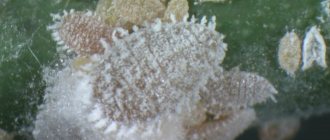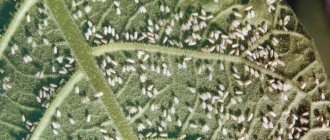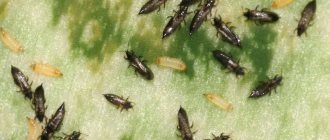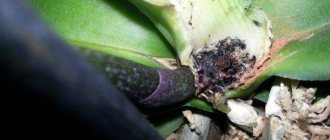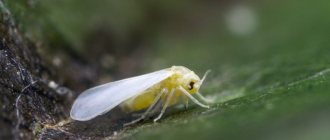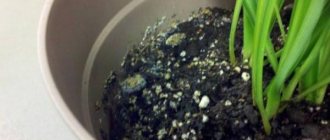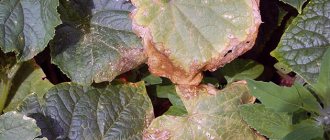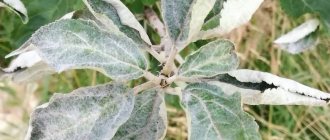If your family laughs at you because you talk to flowers, wiping the leaves and spraying the air around, if your neighbors admire that everything is blooming and growing, and fresh flowers are part of your life and interior, then this article will be useful for you. All “nerds” (in the good sense of the word) sooner or later have some kind of plant health problem. It often happens that small midges suddenly appear in the room, and it is not immediately clear that they live in their favorite ficus or violet. And they not only live there, but also bring certain inconveniences to the flower. Let's take a closer look at what these insects are, where they come from and how to get rid of them.
Whitefly - everything you need to know
The whitefly is an insect from the aphid family. Causes serious damage to plants by sucking sap. It is not difficult to discover that the whitefly has settled on indoor plants (the photo will simplify the task) by itself and is actively laying eggs. To do this, just touch the infected crop - white small midges will surround it with a dense cloud.
Female whiteflies reproduce by laying eggs away from direct sunlight, preferably on the underside of leaves. The larvae cannot fly, so they spend most of their time motionless, gradually becoming covered with a white coating. Under the influence of the pest, parts of the plant change shape, lose color and fall off over time.
In addition, the insect is a carrier of infections.
The most vulnerable to whitefly are delicate indoor plants:
- roses;
- fuchsia;
- orchids;
- geraniums;
- primrose.
In indoor conditions, the insect is capable of infecting these plants throughout the year, flying from one to another around the apartment or house.
Geranium diseases
In Soviet times, geranium (also known as pelargonium) was considered one of the best house plants because it required a minimum of care and rarely got sick. Even the best housewives rarely did more manipulations with the plant than just watering, fertilizing and choosing the right location in the house.
However, over time, more attention began to be paid to the condition of the plant, which is why diseases and pests of geranium began to be studied more closely. Today we will try to figure out what diseases pelargonium should be protected from.
Whitefly at home - reasons for its appearance
To understand how to get rid of whiteflies on indoor flowers, you should study the characteristics of the pests and start with the reasons for their appearance in the house. Understanding what prompted them to settle on flowers will help prevent future infestations.
As a rule, the main reasons for the appearance of dangerous white midges in an apartment are:
- Failure to comply with temperature and humidity conditions.
- Inability to ventilate the room.
- High plant density.
- Infection through newly acquired plants.
High plant density provokes the appearance of pests.
The dangerous whitefly, paradoxically, is also very gentle. It dies if the temperature drops below 15 degrees, and its subsequent appearance becomes impossible.
Creating optimal conditions for pest control
When deciding to fight whitefly on indoor flowers, you need to be prepared for the fact that the process will not be quick and simple. Insects can be removed in several stages, observing certain conditions to prepare for the “war”.
They start with quarantine for infected plants. To prevent the spread of the insect, infected plants are separated from healthy ones and placed in a room with the lowest possible temperature.
If we are talking about flowers that are unpretentious to the cold, such as fuchsia, then the most suitable place for it would be a window sill on an open balcony in late autumn or early winter, when the temperature reaches the desired level. A week will be enough for the white butterflies to die completely.
After the mass extermination of the pest by temperatures, the remains of eggs and traces of adult individuals are washed off with water, and the soil in the pot is replaced with new one. Damaged parts of the plant are removed in order to prevent the formation of putrefactive cells.
Below are several ways to combat whiteflies if the freezing method is not suitable for some reason. For greater efficiency and taking into account the latest generation of larvae covered with a wax shell, several methods will need to be combined to achieve results.
Getting rid of pests on fuchsia and other indoor plants
It is absolutely not necessary to be a qualified florist in order to independently create a home green corner by growing indoor flowers.
However, you should be guided by basic knowledge about plants: for example, what to do if midges appear, since, in addition to aesthetic pleasure, you can get some problems from house plants. Fuchsia fight against whitefly
Types of flower pests
There are two main types of insects that most often infect the leaves of geranium, pelargonium and fuchsia:
Black sciarid insects harm indoor plants
- sciarids are black insects;
- springtails are white midges.
Firstly, in order to establish the main cause of their occurrence, you need to understand what these indoor plant pests are.
Sciarids are dipterous, very small and barely noticeable insects that grow no more than 2 mm in length. As a rule, they can be gray and black. It is quite easy to notice insects, since these midges fly not only near the flower, but also spread throughout the living space.
Reproduction occurs by females laying eggs in moist soil. After a few days, larvae hatch, which subsequently cause enormous damage to the plant. Often, black midges breed in fuchsia.
Collembola white midges are dangerous for house plants
Springtails, or, in other words, springtails can be jumping or crawling insects. They are quite small in size and characterized by a white or grayish color. Their development and reproduction occurs in moist soil. Note that the larvae of these insects are capable of completely destroying the entire root system of plants.
As a rule, these midges most often appear in winter and spring. Springtails prefer to breed on pelargonium, orchid and geranium flowers. In addition, geraniums can harbor aphids, termites, and caterpillars.
The main causes of midges
Note that the causes of plant pests are quite commonplace. However, let's take a closer look at each of them:
Using tea leaves as fertilizer can attract midges to the plant
- Excessively moist soil. Perhaps this is one of the most important factors in the active reproduction of harmful insects. In the case when excess moisture stagnation forms in the pelargonium pot, the midges actively begin their activities.
- Initially contaminated soil. Please note that even at the stage of purchasing a flower in a pot, the soil may already be contaminated, of poor quality and requiring appropriate disinfection. In this case, it is quite difficult to determine the level of soil cleanliness, and in some situations it can be completely impossible.
- Midges can also enter a room through an open window. In addition, another way for insects to get into favorable conditions for development is through ventilation grilles or the most humid places in a living room.
- Pests can infest flowers that are fertilized with tea leaves, coffee solution, humus from leaves or other types of organic substances. As a rule, both sciarids and springtails will happily live in an environment created in this way.
Traditional methods of combating flower pests
Control methods at home
Today, there are a lot of folk methods of combating flower midges, the features of which are given below:
We place garlic on the surface of the soil from pests
- half a teaspoon of potassium permanganate and 2 tablespoons of baking soda must be added to ten liters of water. The resulting product is used as a watering for pelargonium for at least 2 weeks. At the same time, it is recommended to spray the leaves of the plant with warm water. This procedure is ideal for combating larvae located in the ground;
- Using a soap solution can also effectively combat midges. So, 100 grams of laundry soap must be dissolved in 0.5 liters of warm water. After this, use a soft sponge to gently wipe all parts of the indoor vegetation. In parallel with this, it is necessary to water the soil with a solution of potassium permanganate in order to simultaneously get rid of the larvae;
- if there are not very many midges, you can use sulfur.
Ordinary matches are inserted into the ground (heads down). Next, you should water the plants abundantly - this will help provoke a strong smell of sulfur, which will eventually repel insects from the pelargonium; Infusion of dry tobacco for spraying fuchsia - A good remedy is to use garlic cloves. Place them over the entire surface of the soil;
- spread out sprigs of dill with seeds and soil lightly sprinkled with red pepper will also help get rid of harmful insects;
- An effective remedy is an infusion of dry tobacco in the form of a spray solution. To do this, pour 50 grams of tobacco with 1 liter of water and leave to infuse for at least two days. After this, the resulting infusion should be filtered and another 1 liter of water should be added to it. Spraying is recommended to be carried out over several weeks.
Preventive measures
What can you do to prevent the occurrence of black and white midges on indoor plants in the future? We invite you to familiarize yourself with the main preventive methods:
- When buying pelargoniums in a store, you need to carefully examine the soil, as well as the plant itself, in order to exclude the presence of areas affected by parasites.
In addition, it is recommended to purchase an insecticidal substance for soil treatment. Proper care of plants will rid them of pests - It is important to pay attention to soil moisture, since watering the plant should be done only when the soil is completely dry.
- To prevent the root from rotting, it is necessary to ensure a regular supply of oxygen to the soil by loosening the soil.
- It is strictly not recommended to use human food as fertilizer. Today, ready-made fertilizers are available for sale, which are specifically used to fertilize indoor pelargonium.
- When replanting a flower, it is necessary to avoid using a substrate that contains rot and mold.
- An excellent agricultural technique is the addition of finely chopped coconut peel to the soil, which can be easily purchased at specialized flower shops.
Important! For vegetation that needs frequent and abundant watering, a layer of sand should be poured over the soil, which will then dry out much faster than the soil.
So, what is recommended for a gardener to do in order to ensure proper care of indoor plants: monitor the condition of the soil, strictly adhere to the regime of watering and fertilizing the plant, and also provide comfortable conditions for the growth and development of flowers.
A table for replanting plants will help avoid the appearance of harmful insects on plants
Only a systematic inspection of the home flora will prevent further spread of pests, thereby keeping the plants in proper condition.
Video: Caring for indoor Fuchsia plants
Physical impact on whiteflies - what does it come down to?
A proven remedy for whiteflies is mechanical traps. With their help, you can get rid of adult individuals capable of flying. You can make a trap with your own hands from scrap materials.
For a simple sample you will need small plywood sheets or sheets of cardboard. They must be painted in a color that attracts insects (white or yellow), lubricated with castor oil and a mixture of honey and rosin. Baits are placed near the insect habitat. For example, if they settled on fuchsia, then the bait is placed right there - on the windowsill.
As an option for a whitefly trap, simple fly tapes, fixed near the infected plants, are also suitable.
Prevention
To prevent insects from settling in the flowers again after all the procedures, you need to resort to simple preventive actions:
- Before watering, check the soil of the plant to see if it is dry enough;
- drain the soil well to avoid stagnation of water and souring of the roots;
- inspect the leaves from below for accumulations of midges;
- do not overwater or overfeed plants with fertilizers;
- constantly loosen the soil;
- remove bad leaves by cutting them with a sharp blade and treating the cut with crushed coal or cinnamon.
Chemicals against pests - which ones to choose?
If white midges on geraniums or fuchsias have proliferated so much that traps do not save the situation, it is worth moving on to more radical methods of control - using chemicals.
As mentioned above, a proven remedy against whiteflies is Aktara. It is used to treat the soil of plants infected with insects with accompanying spraying. You can increase the effectiveness of the drug by using it together with Actellik. Following the instructions, Actellik solution is used to spray indoor flowers.
A noticeable effect can be achieved by using Tanrek against the white pest. The result obtained in this case will last for at least three weeks, even at high temperatures.
Fitoverm has also proven itself well as a biological insecticide that is not capable of harming plants or humans. Along with it, benzyl benzoate emulsion, Fury, Mospilan, Intavir, Thiazipir and other drugs can be used.
For those who are going to use the drug Actellik or any of the above, the recommendation of adding shampoo or laundry soap to the solution may seem useful. In this case, the effect of the substances will be longer due to adhesion to the surface of the plants.
Ways to get rid of midges in flower pots
To choose the most effective ways to get rid of midges in flower pots at home, you need to understand the mechanisms by which pests appear.
Flower soil in pots is used by midges to lay their larvae in it. The larvae feed on the roots, and then midges appear, which are annoying and interfere with enjoying the beauty of the plant. Most often, midges appear in winter and in those plants that are watered excessively. Although, this is not the only reason why these parasites settle on indoor flowers.
- Overmoistening of the soil. If the water begins to stagnate in the pot, but excess moisture appears. This is the most favorable environment for the development of the described pests.
- Open windows. Fungus gnats, which fly into the house through open windows, can bring midge larvae into flower pots.
- Soil untreated from pests. Often, if the decay processes in the soil have not yet completed, and it was used for growing indoor plants, the pest larvae lay their eggs in such a substrate that is suitable in all respects.
- A colony of aphids on a flower can be settled by ants that feed on honeydew and spread these insects throughout the plants. This often happens in greenhouses, and also when plants are taken out onto the veranda or balcony.
- With a new plant that had aphids.
On the topic of how to get rid of midges in flower pots at home, reviews can be very different. Many home remedies have proven themselves, and their proper use will ultimately allow you to avoid resorting to strong chemicals.
Important! Traditional methods for getting rid of midges in flower pots at home are safer for the plant itself, humans and pets. In most cases, they help quickly and effectively get rid of midges in flower pots.
- Water the soil with a weak pinkish solution of potassium permanganate. It is important here that the color of the solution is pale, otherwise it will be possible to burn the root system of the flower.
- Cut the peel from a ripe and juicy orange and place it in the soil. This is a trap for midges: they will gather for sweet nectar.
- First, stick four matches into the soil, heads down, then water the soil. You need to periodically check the matches and make sure that the sulfur does not completely leave them. If this happens, the match needs to be replaced. As a rule, within a week this method helps to get rid of not only adult midges, but also their larvae that are in the soil.
- You can take garlic and cut it lengthwise. Place thin plates throughout the flowerpot. The method is effective, but you should prepare for the fact that the garlic will emit strong aromas.
- From time to time, water the plant with a weak solution of laundry or baby soap.
- You can chop a few heads of garlic and add a liter of water to them. Leave for four days, then strain the mixture. You will get a garlic solution, which will need to be sprayed on the plant itself and the soil in the pot.
- Tree resin sprinkled onto the soil in the pot will also help. This, by the way, is not only a quick way to get rid of midges in flower pots at home, reviews, but also an excellent additional fertilizer.
- You can hang Velcro near the flower pot. Then adult midges will gather on it.
- You can also use cockroach chalk to get rid of midges. If you should chop it and then scatter it over the surface of the pot.
It happens that several folk methods have been tried at once, but the annoying midges still do not disappear. Then there is nothing left to do but turn to the means of the modern chemical industry.
- "Dichlorvos". Many skeptics relate to this poison, but it is a universal remedy for combating various kinds of parasites. There was a time when this product had an unpleasant and pungent odor, but modern analogues have been improved and this drawback has disappeared.
- "Raptor", "Raid", "Neo".
- Solutions: “Karbofos”, “Aktara”, “Fitoverm”, “Grom-2” and others.
Important! Before using a purchased drug, you should carefully read the instructions. If solutions are taken for control, they must be diluted in clearly indicated proportions, watered the soil, and then refrain from watering the flower for three days.
These are the basic methods for getting rid of midges in flower pots at home or using chemicals. By the way, there are certain groups of indoor plants that are most vulnerable to midges. We are talking about ficus, begonia, azalea and violet. Although, not a single plant is immune from its soil becoming a source of midges.
Source
Dear readers, you can share the article with your friends, use the social networking buttons below!
How to fight a pest using traditional methods?
Homemade decoctions and infusions also give a certain effect when you need to get rid of whiteflies on indoor plants. Compared to chemical drugs, such products are considered safer and more affordable. You can prepare the following types of drugs at home to fight with folk remedies:
- Tincture of yarrow herb (pour boiling water for a day, cool and use for spraying).
- Tincture of wormwood (dry herb is poured with boiling water for several hours, cooled and the plant is treated).
- A solution of laundry soap diluted in water for treating infected indoor flowers.
- A tincture of dandelion roots and leaves for spraying at intervals of several weeks.
- A tincture of dry citrus peels with a small addition of laundry soap.
- Garlic tincture for spraying.
All of the above remedies will help if white midges on fuchsia have not yet reached the scale where it is impossible to cope without chemicals.
Biological methods - what are they?
If actara (you can read how to plant on the packaging) seems too risky, it’s worth trying a biological effect that is more friendly to plant health. For domestic plants, this method of control will be justified only if the flowers are grown in large quantities.
We are talking about the resettlement of a small rider. It is called encarsia and is released into crops at the beginning of the breeding season of the whitefly pest.
This is a predator that pierces the pest larva in order to suck out the lymph and gain vitality.
Packages of ready-made encarsia eggs can be easily purchased at specialized sales points. It is worth remembering that the predator attacks only the greenhouse whitefly and is powerless against tobacco and citrus fruits.
Another natural remedy for pests is the spores of the fungus Verticillium. Applying it to the plant will eliminate insects in a short time.
Consequences of aphid damage
At the initial stage of infection by the pest, geraniums become lethargic and lose vitality. Leaves on young shoots become deformed and look painful. Later, if treatment has not been started, the aphid spreads throughout all above-ground parts of the plants: the shoots become as if “terry” from hundreds of insects clinging to them, the leaves curl, dry out and die, the buds crumble, and those that manage to bloom have severely deformed petals . If at this stage the plant has not been treated with anything, the aphid will finally draw all the juices out of it, as a result of which it will die.

